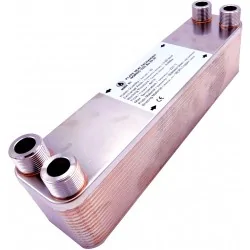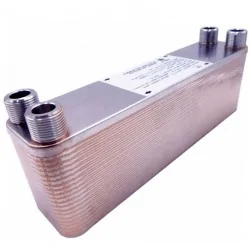Heat Exchangers for homebrewing
Plate heat exchangers for beer wort cooling - Wort chillers
Here you will find several selected models of heat exchangers, recommended for wort cooling. Classic sizes were selected, most often sold for classic brewing sessions, i.e. from 20 to 60 liters. It should be remembered that the larger the heat exchanger (in principle, the larger the heat exchange surface), the faster the cooling process will be, and also more economical in terms of the volume of water needed to optimize the entire process. Our goal is to cool the wort gravitationally so that after a single cooling it reaches a temperature that satisfies us, i.e. about 20-22°, using the most readily available cooling medium, i.e. tap water. Of course, a heat exchanger without accessories should be selected for this application, as thermal insulation or support will not be needed.
 Below are our recommendations - which plate heat exchanger for home brewing:
Below are our recommendations - which plate heat exchanger for home brewing:
PHE Ba-23-20 20 plates, 0.46m² - recommended for novice brewers, for the smallest seassion with a volume of 20-25 liters of wort
PHE Ba-23-30 30 plates, 0.69m² - the most classic model and most often chosen for home brewing among our plate chillers. It seems optimal both for beginners and for quite experienced brewers. Most people spend most of their time doing their hobby rather than reach the point where they need a bigger cooler. It will certainly work for brewing sesions with a size of up to 35-40 liters of wort
PHE Ba-23-40 40 plates, 0.92m² - a beer cooler for brewers who brew quite often and want to reduce the amount of water used for cooling - or for people planning larger batches, with a volume of wort up to 45-55 liters
PHE Ba-23-50 50 plates, 1.15m² - a chiller for the most advanced brewers for whom the quick cooling time of the wort is of particular importance. For larger home brews, e.g. 60-65 liters of beer wort per session.
Plate Heat Exchangers in beer production in home brewery
Anyone who has embarked on the journey of brewing their own beer knows well how intricate the process can be . Before you can savor the taste of your favorite brew, you need to go through a series of steps - mashing, wort filtration, sparging, boiling the wort, fermentation, bottling, and aging. Speeding up this process is possible by investing in a plate heat exchanger for home brewing from Nordic Tec. This device significantly accelerates the wort cooling process after boiling. Before adding yeast, the wort needs to be cooled to a temperature of 8-12°C for bottom fermentation yeast or 15-20°C for top fermentation yeast. Using a heat exchanger for beer production greatly streamlines this process and accelerates alcohol production. This device is particularly valuable when planning to produce larger quantities of beer and traditional methods like immersion of the wort vessel in cold water fall short. Explore our selection of heat exchangers for home brewing and choose the appropriate model that will assist you for many brewing seasons, as these devices are exceptionally durable.
Store with Heat Exchangers used in beer production - Nordictec-store.com
The product range of the online store Nordic-sklep.pl includes a wide selection of plate heat exchangers for home brewing. Despite the variety of heat exchangers available on the market, including spiral and tube heat exchangers, it's the plate heat exchangers that garner the most interest in the food and beverage industry - and likely offer the best balance between price, efficiency, and convenience, as they occupy minimal space compared to other types. They operate highly efficiently, allowing for quick cooling of hot wort or other liquids, and their cleaning process is remarkably straightforward and trouble-free. With the heat exchangers available in our store, the beer production process becomes much simpler and more enjoyable. We encourage you to explore our offerings!
Home Brewing - Essential Equipment
How is beer made? Most of us would answer that it's made from malt, hops, yeast, and of course, water. However, few realize that to produce beer, you need to equip yourself with a range of professional equipment, including the aforementioned plate heat exchanger for cooling the wort. The following elements are also essential during the beer brewing process:
- A large pot with a capacity of around 30 liters.
- Two fermenters, one of which should have a drain valve.
- A thermometer with a scale up to 100°C.
- A mash paddle for stirring the mash.
- A hydrometer (alternatively a refractometer) for measuring the wort's density.
- A filter system.
- Drain hoses.
- A capper for sealing bottles.
- Sanitizing agents.
- A gas stove or gas burner.
- A kitchen scale.
Plate Wort Chiller - What is the purpose of a Heat Exchanger in home brewing?
A plate wort chiller - or just a plate heat exchanger for home brewing is a device composed of stainless steel plates designed to meet the needs of homebrewers . These are smaller versions of industrial coolers used by commercial breweries. The models available at Nordictec-store.com are characterized by user-friendly operation and ease of maintenance. The primary purpose of heat exchangers in beer brewing is to streamline the wort cooling process after boiling and before yeast addition.
Benefits of Using a wort plate chiller for home brewing
Among the advantages of the wort plate chillers for home brewing available at Nordictec-store.com are:
- Rapid wort cooling: Using our provided solutions, you can cool the wort to the required temperature within minutes, significantly reducing the risk of contaminating the wort.
- Ease of cleaning: After use, the heat exchanger for home brewing can be easily cleaned and prepared for reuse at a later time.
- Efficient operation: The cold water consumption for plate heat exchangers in home brewing is much lower compared to immersion chillers.
How to choose the brewery heat exchanger or homebrew chiller?
A homebrew chiller - or the brewery heat exchanger is an essential device for producing high-quality beer at home . But how do you choose the right model? The primary criterion to consider is the plate surface area, which determines its efficiency. The surface area of the wort heat exchanger you invest in should primarily depend on the amount of beer you are producing and the temperature of the cooling water that will be used to chill the hot wort ( commonly using tap water at around 15°C ). The larger the quantity of beer, the larger the heat exchanger's plate surface area needed for efficient operation. For home brewing, heat exchangers with cooling surface areas of 0.40 - 1.00 m² are most commonly used, capable of rapidly cooling typical batches ranging from 20-70 liters of hot wort.
Another crucial aspect in choosing a chiller for wort cooling is its design. Plate heat exchangers are the most commonly used type, enabling quick and effective wort cooling. Plate heat exchangers consist of plates that are washed by the cooling water, extracting heat from the wort. It's important that the heat exchanger is also easy to clean, ensuring the production of high-quality beer. In essence, plate models fulfill this requirement.
Price is another factor to consider when choosing a brewery heat exchanger. Homebrew chillers with higher capacity usually come at a higher cost. It's worth considering the quantity - or rather the volume - of beer you plan to produce and how frequently the heat exchanger will be used to select the best option .
In summary when purchasing a wort chiller for home brewing, pay attention to its capacity, design, and cost. It's also important that the chosen model is user-friendly and easy to clean, ensuring effective and efficient wort cooling and, consequently, a high-quality final product.
How to use a plate heat exchanger in Home Brewing
As mentioned above - a plate heat exchanger for home brewing consists of a set of stainless steel plates that wash the liquids flowing through the device. In the heat exchanger, the working fluids do not mix. Only heat energy is exchanged between them. To maximize PHE efficiency, it's recommended to position the the plate wort chiller vertically. Then, connect the hoses in a way that the wort is pumped in from the bottom of the device, and the cooling water enters from the top. This setup ensures that the water flows in the opposite direction to the wort (counterflow principle), optimizing performance. The channel selected for the wort in the Nordic Tec plate heat exchangers can be either one, as the channels have the same capacity and efficiency . This is an important piece of information to remember - the efficiency of brewing heat exchangers can also be increased by pumping liquids through the device in opposite directions.




